Landsec and Bryden Wood have come up with an office design prototype that aims to be quicker, more sustainable and cheaper than conventional methods of construction

How do office developers deliver better‑quality schemes more quickly, cheaply and sustainably? Particularly when, unlike some other traditional building techniques, office construction is already pretty slick. Steelwork sections are factory fabricated and are quickly bolted together on site. Composite floors are relatively quick to build because the metal decking acts as permanent formwork for the concrete slab. Unitised cladding systems are factory made and are quickly assembled on site, and modularised service installations are becoming the norm.
But this was not good enough for developer Landsec. “Building delivery is becoming progressively more challenging in a world where skilled labour is very much in demand,” explains Neil Pennell, Landsec’s head of design, innovation and property solutions. “It’s important that we deliver more with less going forward, so productivity improvements are really important, particularly in construction because it lags behind so many other industries.”
Pennell’s job is to find a solution to this challenge. Landsec wanted five key outcomes – being able to deliver buildings faster, better, more cost-effectively, more safely and more sustainably. After researching the options, Pennell settled on the platform approach developed by architect and offsite manufacturing specialist Bryden Wood.
Called the platform approach to design for manufacture and assembly (P-DfMA), Landsec has adapted the system, which was originally developed by Bryden Wood for the Ministry of Justice for new-build prisons, for a commercial office building in London’s Southwark. Called The Forge, the building will also be the first to meet the UK Green Building Council’s definition of a net zero office.
The platform approach was used to construct the frame but also has benefits for the cladding and services installation. Here, we look at what the system is, how it works and how the project team got on.
The guinea pig
The 140,000ft² project consists of two 10-storey buildings, one of 90,000ft² and the other 50,000ft². The Piercy & Company-designed scheme was originally going to be built conventionally, but Landsec identified it as the ideal guinea pig for this new construction approach. Handily, this has made it easier to benchmark P-DfMA against traditional construction, including the carbon impacts.
Construction management was adopted as the ideal procurement route for this project as it enabled Landsec to get closer to the supply chain and gave it the flexibility to make changes without being penalised for variations. Pennell says he prefers the term “manufacturing and assembly manager” to “construction management”. “We wanted to emphasise the focus on logistics and managing the assembly process on site,” he says.
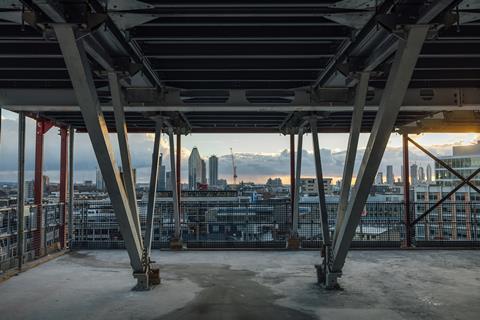
Pennell says that interest in the job was very high because of the opportunity to learn from the process. Unusually for a project of this size, Sir Robert McAlpine and Mace have formed a joint venture because of their enthusiasm for this job.
“It was great to see Mace and Sir Robert McAlpine so keen to be involved,” Pennell says. The two contractors are working as one team, with the commercial side being led by Mace and the programme by Sir Robert McAlpine.
Key specialists were brought in early under pre‑construction services agreements to contribute their expertise to the design to help ensure the benefits of P-DfMA were maximised. “The difference here is that the thinking and the design was done at the earliest possible stage,” Pennell says.
We needed to ensure the structure would give good column-free space, which is what is expected in a quality office product
Neil Pennell, Landsec
Platforms are a set of standardised components that are assembled using a standardised methodology with the idea that this can be used for a range of similar buildings. This is like car production, where the same platform is used for different models – for example, the Volkswagen Group spent billions developing its MQB platform which is now on its second iteration and is used for smaller Audi, VW, Seat and Skoda models. “Like any manufactured product, the chassis or frame is really important because that is what you build your final product onto whether it is a car or a printed circuit board. It’s perceiving a building in those terms, as a product,” Pennell says.
Developing the platform system
Architect and engineer Bryden Wood has been developing DfMA solutions for clients for 25 years. Jaimie Johnston, head of global systems, says the platforms approach was the culmination of that experience.
“It is a crystallisation of 25 years of different forms of DfMA that we have developed for different clients, and we are now bringing it together into a cohesive whole,” he says.
The platform approach was developed for the Ministry of Justice (MoJ) over five years ago for its prison estate transformation programme. The use of platforms is gaining traction because of the efficiency gains it could bring. A core policy of the Construction Playbook is to accelerate and promote the use of platforms, because the Construction Innovation Hub has calculated that of the £50bn pipeline of work for health, housing, justice, defence and education buildings, £35bn is suitable for delivery using platforms.
The Infrastructure and Projects Authority has gone one step further with its Transforming Infrastructure Performance: Roadmap to 2030, which was published in September 2021. It is proposing to set out a mandate for the use of platforms for social infrastructure projects in the next two years. “Platforms are coming, definitely coming – but the market hasn’t quite got its head around it yet,” Johnston says.
Landsec’s Forge is the exception to that sentiment. Johnston describes it as the “Goldilocks” project for this experiment because it had planning permission, an architecturally specific design that was not so far advanced that it could not be tweaked, and was a city-centre site with all the constraints that entails.
“It was a really good test case for platforms because if the only things you could build with platforms are very rectilinear, dull, cookie-cutter buildings, then they probably aren’t much use to anyone,” Johnston says.
He says the vast majority of components and processes used at The Forge were developed for the MoJ platform. The main difference was to extend the grid to 9m, so the new components here are the primary steel beams.
The system had to be able to deliver a standard office product. The Forge features 9m spans and the building frame is a steel and concrete hybrid, just like a standard office.
“We needed to ensure the structure would give good column-free space, which is what is expected in a quality office product,” Pennell says. Precast slabs were ruled out on the grounds of significantly increased cost.
The steel frame is like a standard frame with the difference being that the primary beams, which are 9m apart, are standardised with uniform cut-outs in the web for services. The primary beams are also designed to integrate with the secondary beam system. The columns span from floor to floor and are also standardised although the wall thickness of the columns increases towards the ground floor to handle the increasing loads.
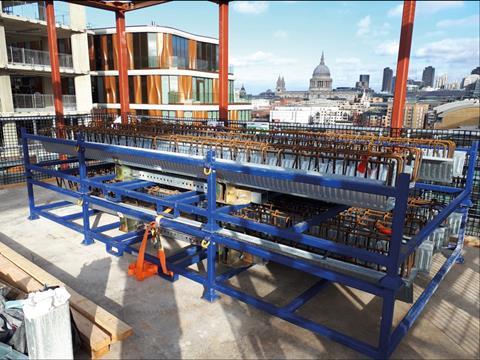
The steel frame goes up like any other building with the main difference reserved for the slab construction. The secondary beams, which span between the primary beams, are spaced at 3m intervals.
A permanent steel shutter, which is one section of ComFlor, the composite floor decking system, is lifted into position with a reach stacker, a machine used in the logistics industry. This slots into dedicated shoes in the primary beams. The ComFlor is lifted with rebar already in place with a temporary support bar.
Shutter tables, also prefitted with rebar, are then lifted into the space between the ComFlor beams and fixed to the temporary support bars on the beams. The whole assembly is supported by diagonal braces spanning between the temporary support bars and stumpy mini columns in the floor below, which are in turn bolted to the beam below. Self-compacting concrete is then poured over the whole floor to create the slab and complete the ComFlor beams.
Speed
The beauty of the system is that work can continue on the floor above as soon as the concrete has set, as the team is not reliant on this curing first. “It enables us to build quickly even though we are using a concrete solution,” Pennell explains.
“Normally, with a concrete slab you would have to wait for the slab to reach strength before starting work on the temporary works used to create the slab on the next level. You might have to wait weeks for it to reach a sufficient level of strength. Using the diagonal props, the loads transfer to the primary steel structure – which means that within 24 hours of casting the slab the team can start constructing the next level.”
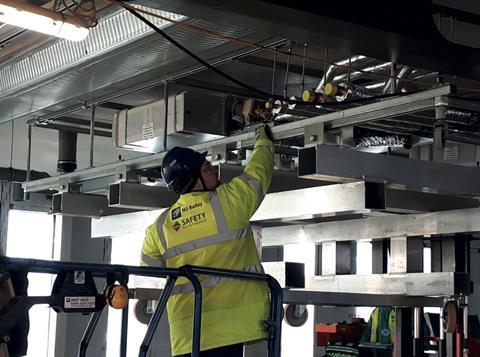
Another benefit is that more granulated ground blast-furnace slag can be incorporated into the concrete mix to reduce embodied carbon, as the slower curing time matters less. Other benefits include reduced demand on the crane. Materials are lifted into position in stillages, and using reach stackers for lifting elements into place further reduces crane time. Crucially, this reduces the risk of work having to stop in high winds.
The temporary works system is designed to be reusable on other buildings. It is also flexible, as different floor heights can be accommodated by the system. A series of holes in the ComFlor support beams and brackets capable of pivoting on the mini columns at floor level allow the angle of the diagonal bracing to be adjusted. The Forge has two different heights, 3.5m for the standard office areas and 3.7m for the terraced areas.
How did the team get on with the system? Angela Branch, project director for Sir Robert McAlpine, says it took a while for the team to get up to speed.
“It is fair to say there was a very ambitious cycle time of 15 days [per floor] and we did achieve that – but it took quite a lot of learning to get there,” she says. “We had to completely re-educate the concrete frame guys.
“We had Coffeys install the steelwork and concrete, which was deliberate as they are so intrinsically linked – you cannot do one without the other. The temporary works are completely bespoke and have some quite precise, industry-beating dimensional tolerances, which again we had to go through quite a learning curve to get those understood and completely accurate on site. We got quite whizzy by the end, but it took us a while to get there.”
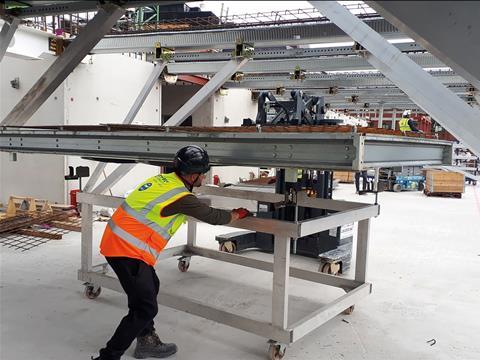
Those close dimensional tolerances have downstream benefits for the services and cladding installation. A lot of thought went into the services installation at an early stage, with NG Bailey and Bryden Wood. This included packaging up the services so that these took up the minimum amount of space and also standardising as much as possible to drive efficiency into the construction process.
As Pennell explains: “We were able to maximise the clear height of the space through a combination of optimising the structural and service zones and with an accurate structure so we could be confident it would all fit together. This meant we didn’t have to overcome lots of co-ordination issues, which is why people put big service zones in buildings.”
The slab-to-slab height of 3.5m is about as low as it is possible to go in an office building. There is 2.75m from the top of the raised floor to the underside of the lowest beams.
There was a very ambitious cycle time of 15 days per floor, and we did achieve that – but we had to completely re-educate the concrete frame guys
Angela Branch, Sir Robert McAlpine
The first simple but significant services installation innovation was casting the soffit fixings into the slab rather than drilling these afterwards. A total of 23,500 special threaded inserts were placed through holes in the slab shuttering before the concrete was cast.
“That’s 23,500 times someone hasn’t got to go high up with a hand drill with all the arm shake and the dust going into their eyes. They will only have to drill things by exception where they haven’t got a fixing in the right place,” says Pennell.
The services arrive assembled on frames – for example, a module could contain a fan-coil unit, diffusers and the four pipes feeding the fan-coil unit with hot and chilled water. These are stacked with rods separating each frame so several modules can be brought in one lift.
The modules are lifted up to the soffit and bolted to the inserts already in the slab. A smaller version of the reach stacker used for the ComFlor beams and slabs was used for this job. Pennell says the team started off using Genie lifters as they had to wait four to five weeks to get the reach stackers delivered. This radically speeded up the services installation, with NG Bailey saying it wanted these lifters for future jobs.
Safety
A safety handrail is integrated into the edge slabs. The cladding installers wanted to remove these, as they are used to working attached to safety lanyards and thought the handrails would slow them down. The handrails were not going anywhere so the cladding team had to work around these and were surprised to find that they worked more quickly.
“The reason was the guys felt safer when they were doing it,” Pennell says. “Normally, if they are working on a lanyard on an exposed edge, they work very deliberately because they don’t want to fall off the edge because although they are secured it is not a pleasant experience.”

The tolerances on the cladding brackets were a close plus or minus 5mm, which the cladding team had to adapt to. Branch says some remediation work was required on the brackets as the tolerances were too tight – the issue is that the tolerances at The Forge are tighter than those in the National Structural Steelwork Specification which is the industry standard. Pennell says the intention with the tight tolerances was to “push the envelope as far as possible”.
Once the issue with the brackets was resolved the panels went on very quickly – at the peak, one panel was being installed every seven-and-a-half minutes. “The challenge now is to find ways to provide the logistics support behind that, because you have to shift a lot of material to keep pace with that speed of fixing,” Pennell says, adding that the whole logistics process will need to be rethought to maximise the benefits from more efficient ways of working.
Digital tools underpinned the whole process and were supplemented with some new ideas to improve efficiency still further. This included using QR codes to identify individual components. These enabled the teams to track components from the time these left the factory right through to installation.
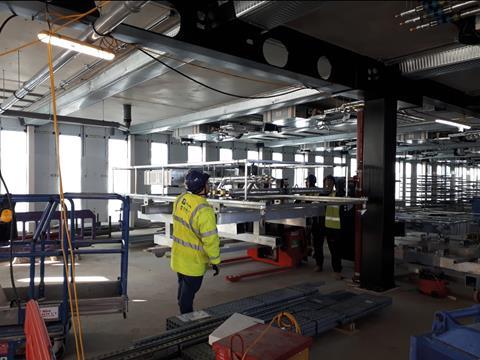
Pennell says the workers were reluctant to use the QR codes at first but once they realised that these made their jobs easier they embraced the idea. According to Pennell, there were 30 different ComFlor variations, which looked similar. QR codes made it quick and easy to identify the correct ones.
Elsewhere, the lift cores were constructed from twinwall panels and the steel stairs were brought in as complete units. These bolted together to form a rigid box up through the building, providing lateral stability. Some areas of the building, about 20%, had to be constructed traditionally – for example, the double-height ground floor and the zone adjacent to the perimeter as this had to fit within the planning footprint.
The frame is finished, the services and cladding panel installation is well under way – so what are the lessons from the job? It has been a big learning curve for the team, which means that overall it has not reduced cost or time, particularly because the team had to contend with both the pandemic and Brexit.
Branch says it would be hard to clearly see the benefits without doing two more projects using this approach. Pennell says time could be saved at the design stage on future projects because using standardised components means projects are not being designed from scratch each time.
And he points to the times when the team did hit the targets for the structure and the speed at which the cladding went on. “The opportunity is there,” he says. And the efficiencies inherent in the platform approach have resulted in reduced steel and concrete use (see below).
Achieving net zero
The Forge is the UK’s first building to align with the UK Green Building Council’s definition of net zero and is on course to achieve a Nabers 5* rating. Helpfully, the building had already been designed as a conventionally built, fossil fuel-fired scheme, enabling the team to benchmark the carbon savings by adopting the net zero target.

The first thing to go was the gas boilers, which have been replaced by roof-mounted air-source heat pumps. This enabled the basement size to be drastically cut – originally it extended under both buildings – so that it now sits partially under just the bigger, 90,000ft2 one.
This equates to a reduction of 53% in area and 70% by volume.
The space reduction was helped by creating a mezzanine over part of the double-height ground floor with plant at ground level and office space above. “This has probably got the smallest basement to built area of any project that we have delivered,” Pennell says.
This has huge carbon reduction benefits as basement construction is one of the most carbon intensive aspects of any job – with a reduction in substructure carbon of 40% compared with the original design. The substructure concrete is 50% ground granulated blast-furnace slag (GGBS).
Adopting the more efficient platform approach has also cut carbon emissions as there is 18.4% less steel and 13% less concrete against the benchmark. It has also enabled the use of 40% GGBS in the floor slabs, thanks to the fact that the team is not relying on the strength of a completed slab before starting the next floor. This equates to a 21% reduction in embodied carbon as a result of using P-DfMA.
Overall, the embodied carbon of the whole building has been cut by 25% compared with the original design.
Pennell adds that there has been huge interest in the project, with visits from the Ministry of Justice, the NHS, the Department for Business, Energy and Industrial Strategy and the Cabinet Office. Interest from the public sector is particularly high because of the ambition to use platforms for public sector projects in the Construction Playbook.
The project has received funding from UK Research and Innovation, which is collecting all the lessons from the project for dissemination to the wider industry. The system is available for use by anyone and could be easily scaled down for schools, healthcare and other buildings.
In time, manufacturers could offer systems to fit a range of grid sizes, which would bring costs down and mean more of a building could be constructed using the system as a different grid size would be available for the perimeter zone, as well as smaller buildings. Given the years that have been invested in developing and refining the system, the challenges facing the industry and the push to use platforms by government, the time to use these is now.
Project team
Client Landsec
Architect Piercy & Company
Architect and P-DfMA consultant Bryden Wood
Cost consultant Gardiner & Theobald
Construction managers Mace and Sir Robert McAlpine
Steel fabrication DAM Structures
Concrete and steel erection J Coffey
MEP NG Bailey



























No comments yet